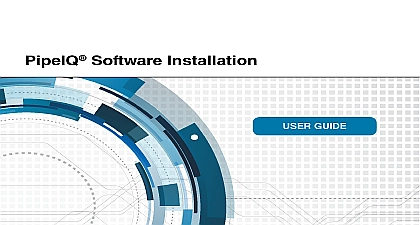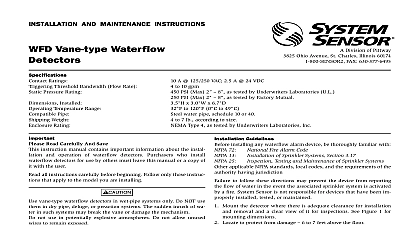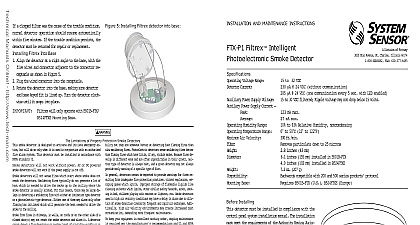System Sensor Pipe Installation

File Preview
Click below to download for free
Click below to download for free
File Data
| Name | system-sensor-pipe-installation-4201563798.pdf |
|---|---|
| Type | |
| Size | 4.70 MB |
| Downloads |
Text Preview
Aspirating Smoke Detector Installation GUIDE of Contents of this user guide 3 a Pipe Network 3 Overview 4 Network Components 4 Methods 11 Pipe Network Sampling 11 Tube Sampling 11 Area Protection 12 4 Sampling 12 Temperature 4 4 Below Beam Sampling 13 Floor Protection 13 and Unions 4 4 Void Sampling 13 Protection 14 4 Sampling 14 Caps 5 Sampling 14 Tubes and Sampling Ports 5 Brackets 5 5 Network Installation 6 Sampling 14 Area Protection 15 Area Protection 15 Air Exchange Areas 16 Pipe 6 Components 6 Air Sampling 16 Sampling 17 the Pipe Network 6 Considerations for In Duct Sampling 17 Bends 6 Duct Sampling 17 Sample Ports 7 Duct Sampling 18 Stages 7 and Design 8 8 Orientation 18 Voids 18 Pipe Cleaning Maintenance 19 Requirements 9 Network Maintenance 19 Layouts and Measurements 10 Maintenance 19 Details 10 Conditions 10 Design 10 Guide Aspirating Smoke Detector Pipe Installationfirealarmresources com purpose of this user guide is to provide details on the physical installation of the pipe network for the FAAST Fire Alarm Aspiration Technology aspirating smoke detector Local codes and regulations may vary and take precedence over the information in this user guide of this user guide a Pipe Network FAAST detector and its pipe network allow deployment of smoke detection in challenging and mission critical environments In to ensure the system will operate in accordance to site specific requirements as well as local codes and regulations the pipe must be designed and verified using the PipeIQ software PipeIQ can be downloaded at systemsensor com faast Guide Aspirating Smoke Detector Pipe Installationfirealarmresources com Overview Network Components FAAST detector uses standard aspiration fire detection pipe components such as pipes elbows and couplings components listed in this section are not an all inclusive list they represent the most commonly used items pipes used in the pipe network can be made of various including copper PVC ABS UPVC and CPVC The pipe diameter used with the FAAST system can range 0.591 to 0.827 15 to 21 mm Ideal dimensions vary on system design requirements as well as local and regulations The FAAST detector has a built in tiered point for the pipes which allows for an outside tube of either 1.050 or 25 mm to accommodate U S System and Metric System Sized Pipes Asked Question Can we use metal pipe instead plastic with FAAST It is acceptable to use either steel or copper pipe under the conditions The pipe size used must be capable of fitting to a plastic upon interfacing with the FAAST device The inner must be within the approved range of 827 15.00 21.00 mm The material must be approved by the local authority jurisdiction and must also be approved by the underwriter Temperature selection may be contingent on the temperature of the in which the pipe will be mounted Table 1 shows ranges for various types of pipe Material Temperature 80 40 to 176 to 60 58 to 140 to 60 58 to 140 to 93 15 to 200 to 49 15 to 120 to 110 238 to 230 1 Temperature ranges for various types of pipe For specific design considerations in cold temperature download the Cold Storage White Paper from are used to connect sections of pipe together on longer runs and are made from the same material as the pipe are several types of fittings to allow for various bends runs branches and connections Common fittings are in the following sections and Unions and unions are used to connect two sections of pipe a straight line A coupling is used when the section is not to be taken apart union offers the ability to screw the two pipe sections together future access such as areas of the pipe network that have be periodically disassembled for maintenance and cleaning can also be used to orient sample ports correctly in specific section of the pipe network such as over return grilles for more information on high air flow and duct see the white paper at systemsensor com faast 1 shows a typical union and coupling 1 Couplings and unions are used to change the direction of the pipe network 45 degree and 90 degree elbows may be used Both fittings are shown in figure 2 2 Elbows are also used for branching into multiple pipes from a pipe network A specialized tee can be used to attach a tube and a sampling port A tee is shown in figure 3 3 Tees Guide Aspirating Smoke Detector Pipe Installationfirealarmresources com Caps Brackets end of the pipe should be terminated with an end cap The cap may have a sampling port depending on the system The size of the port in the end cap is determined by the software An end cap is shown in figure 4 pipe network is mounted to the ceiling or other appropriate using mounting brackets A large variety of brackets available from a standard pipe supplier Typical brackets clips saddle clamps or tie wraps as shown in Figure 6 mounting choice will depend on the material being mounted environmental temperature and local codes and regula Mounting brackets are usually centered 5 ft 1.5 m apart using 3 4 schedule 40 pipe at 70 21 At 140 this reduces to 2.5 ft between support brackets Open mounting clips should not be used in an inverted position the open section facing downward because the pipe could from the clip 4 End caps Tubes and Sampling Ports capillary tube is a length of flexible tubing that is connected the main sampling pipe with a sampling port at the end purpose of these tubes is to extend the placement of the being sampled away from the main pipe network This may necessary to reach in t


